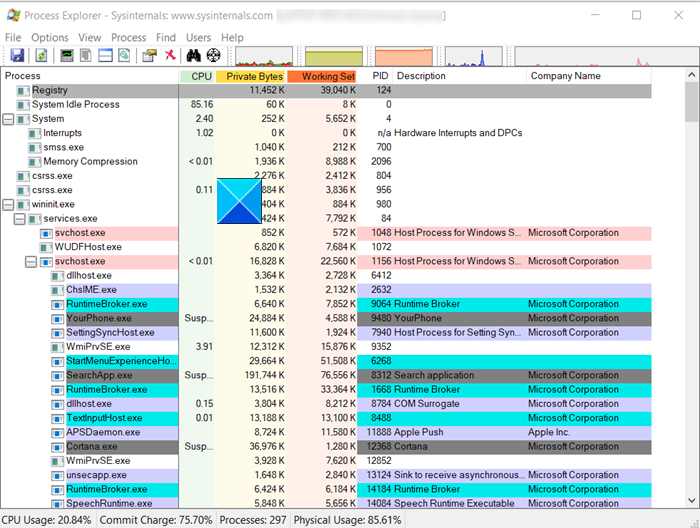

- #SYSINTERNALS PROCESS EXPLORER WINDOWS 10#
- #SYSINTERNALS PROCESS EXPLORER SOFTWARE#
- #SYSINTERNALS PROCESS EXPLORER DOWNLOAD#
- #SYSINTERNALS PROCESS EXPLORER WINDOWS#
it can even act as an anti-virus or show you precisely what a program is doing. PE has a massive edge over Task Manager because of its all-around utility. There are some fundamental differences that make these two competitors. Should I replace Task Manager with Process Explorer? Other than that, PE displays the company that produces the program and what it does in your system.
#SYSINTERNALS PROCESS EXPLORER SOFTWARE#
If that number is higher than two, the software is most likely a virus. Underneath the virus total tab, Process Explorer will display a number. Then it will check all the processes running against the versions available on the website that are updated regularly by Google and other developers as the most up to date virus compilation. If you select it, it will take you to the website where you need to give it permissions. Here you can find Virus Total, which enables you to search for programs that might be viruses. One other essential tool to mention is under options. This tab features more functions like properties, process trees, and so on. This option allows you to find malfunctioning files and even trace potential viruses. What features does it come with?įurther, you can see the binoculars, which allow you to find the handle or DLL of any program. To the left, there is a circle with arrows pointing outwards, which allows you to find the process that is running. This area also displays I/O and GPU status. CPU is color-coded with green, while System commits are yellow, and RAM or physical memory is shown as orange-red.ĬPU, Commits, and RAM corresponds to the live time graphs shown to the right above the tabs. The vital system programs running are highlighted in red. The first elements to look at are the processes. It is not intuitive, but it does not take a sharp learning curve to be able to use it effectively. Once you have Process Explorer downloaded and running, you will see a rather complicated interface. Select the Task Manager in the window that opens up.


If you decide to replace TM, you simply have to hit alt-ctrl-delete at the same time. You will always have to run it from that file unless you decide to replace the task manager with it.
#SYSINTERNALS PROCESS EXPLORER WINDOWS#
The manager works on any Windows operating system after Windows 98 including Vista. Once the program is extracted, you must run the application appropriate to your computer. Once downloaded, you can extract the file to any other location.
#SYSINTERNALS PROCESS EXPLORER DOWNLOAD#
You need to download the software off the internet.
#SYSINTERNALS PROCESS EXPLORER WINDOWS 10#
If it’s worth the time to use one of these tools then it’s probably worth the time to use both, and you will commonly find yourself doing this.PE does not come installed on the computer on Windows 10 or any other Microsoft OS. In daily use I often start with Process Explorer to find processes which are consuming a lot of system resources and then move to process monitor to dig deeper into these processes. Using it you can find out what files, DLLs, and registry keys particular processes have open and the CPU and memory usage of each. Process Explorer is considered to be a more advanced form of the Windows Task Manager. You can think of this as a combination of the old FileMon and RegMon tools with some basic diagnostic features. This tool will display information regarding the file system, registry, and the processes running on the system as they are occurring. Process Monitor is a real-time troubleshooting tool. I’ve written tips on both of these and frequently see people confuse them or even ask about the differences between the two. Process Monitor and Process Explorer both have a lot in common as they are both Microsoft Sysinternals tools designed to help you troubleshoot and debug processes on a Windows host.


 0 kommentar(er)
0 kommentar(er)
